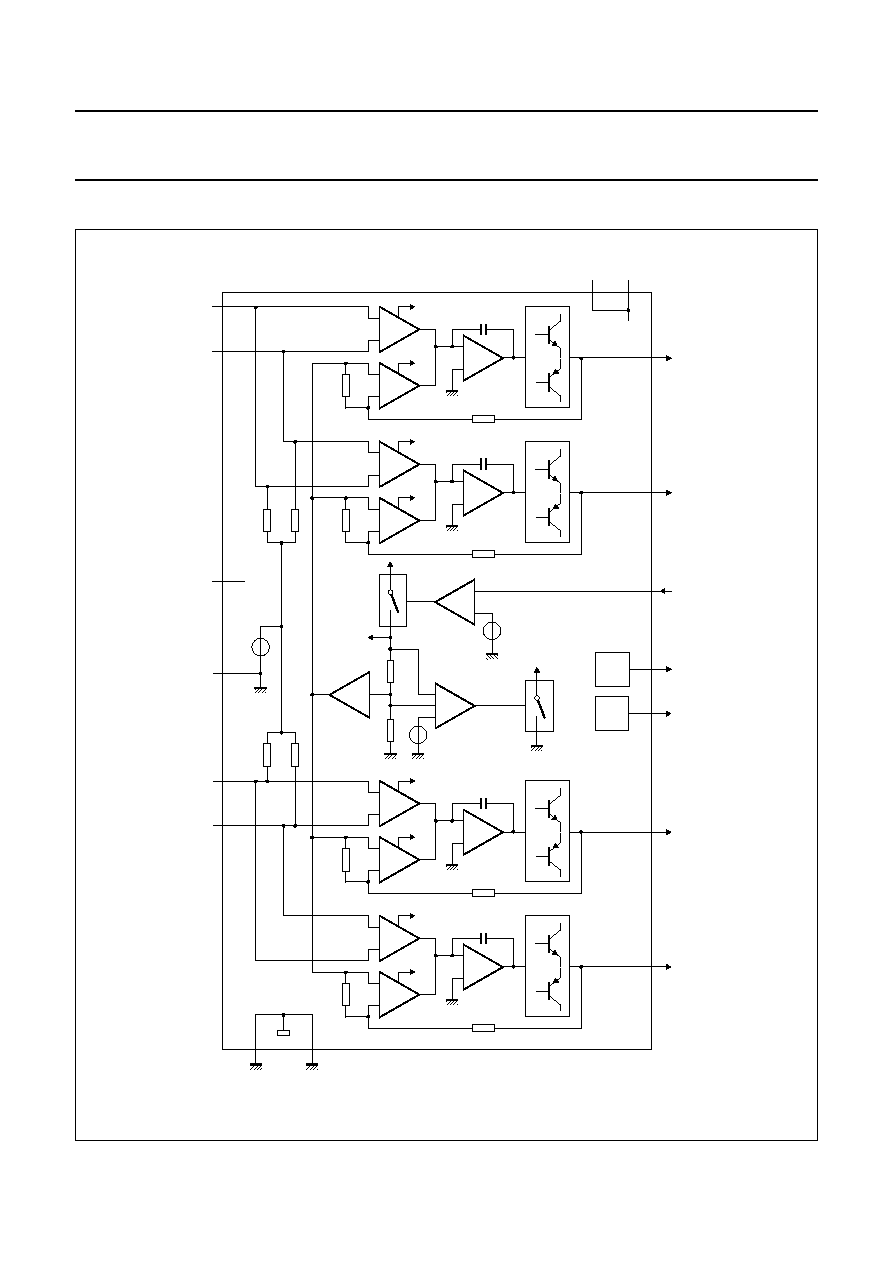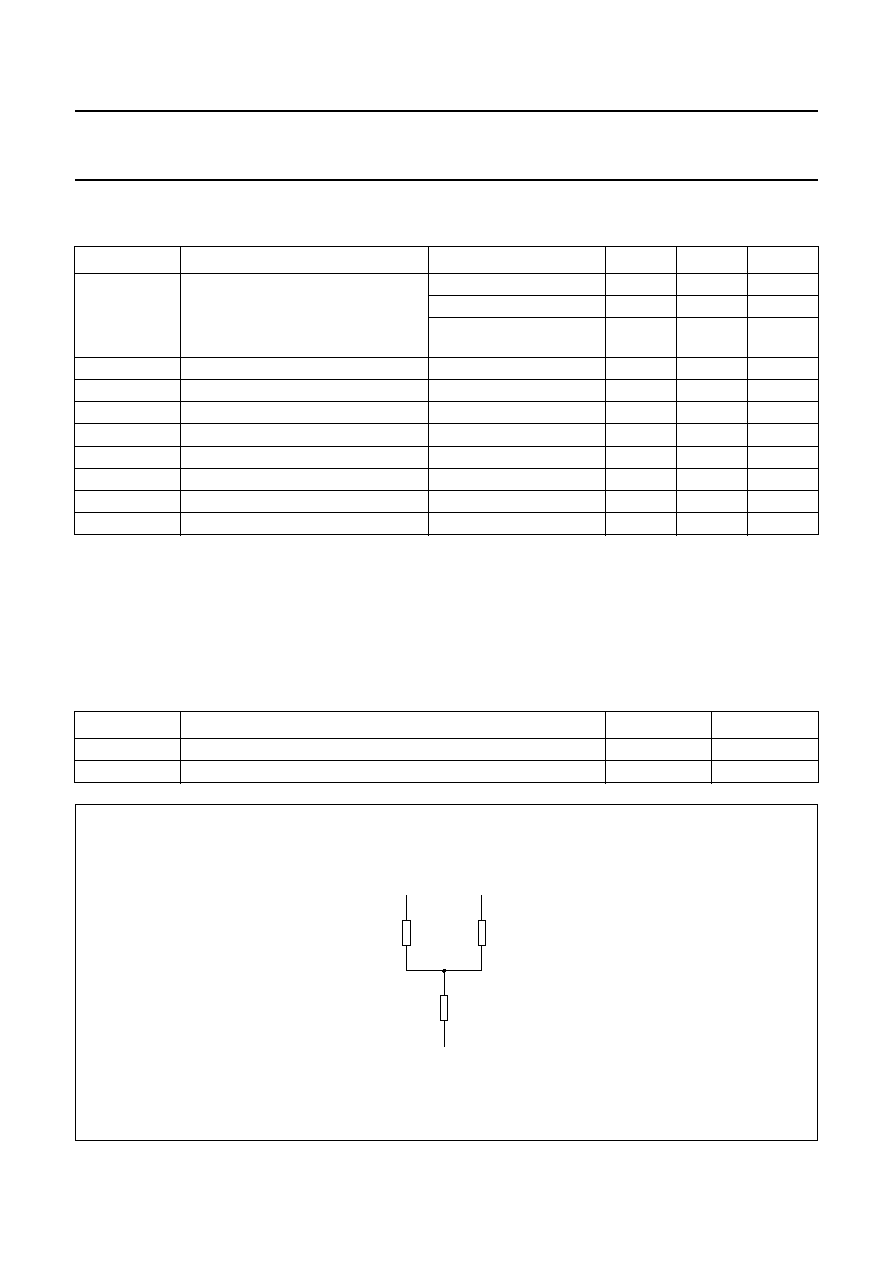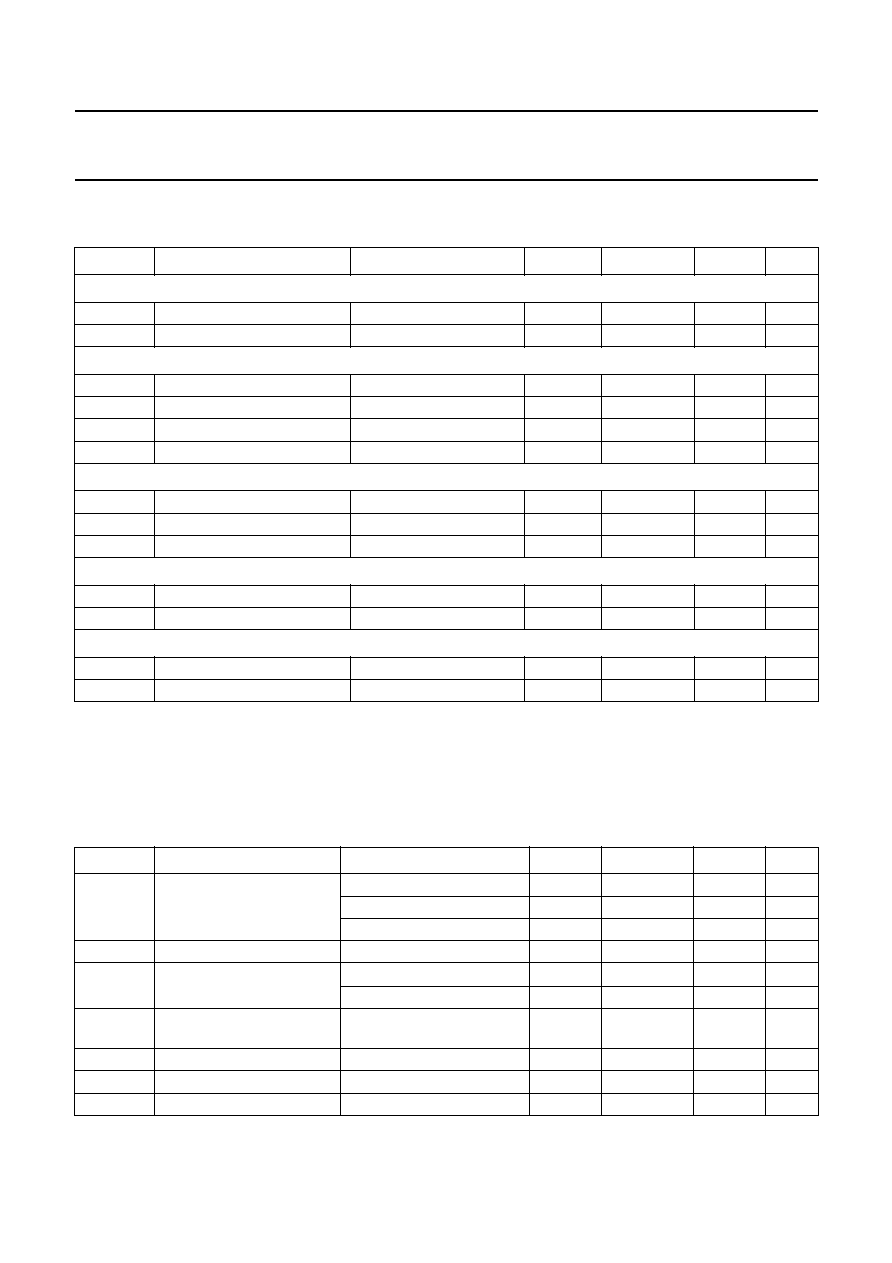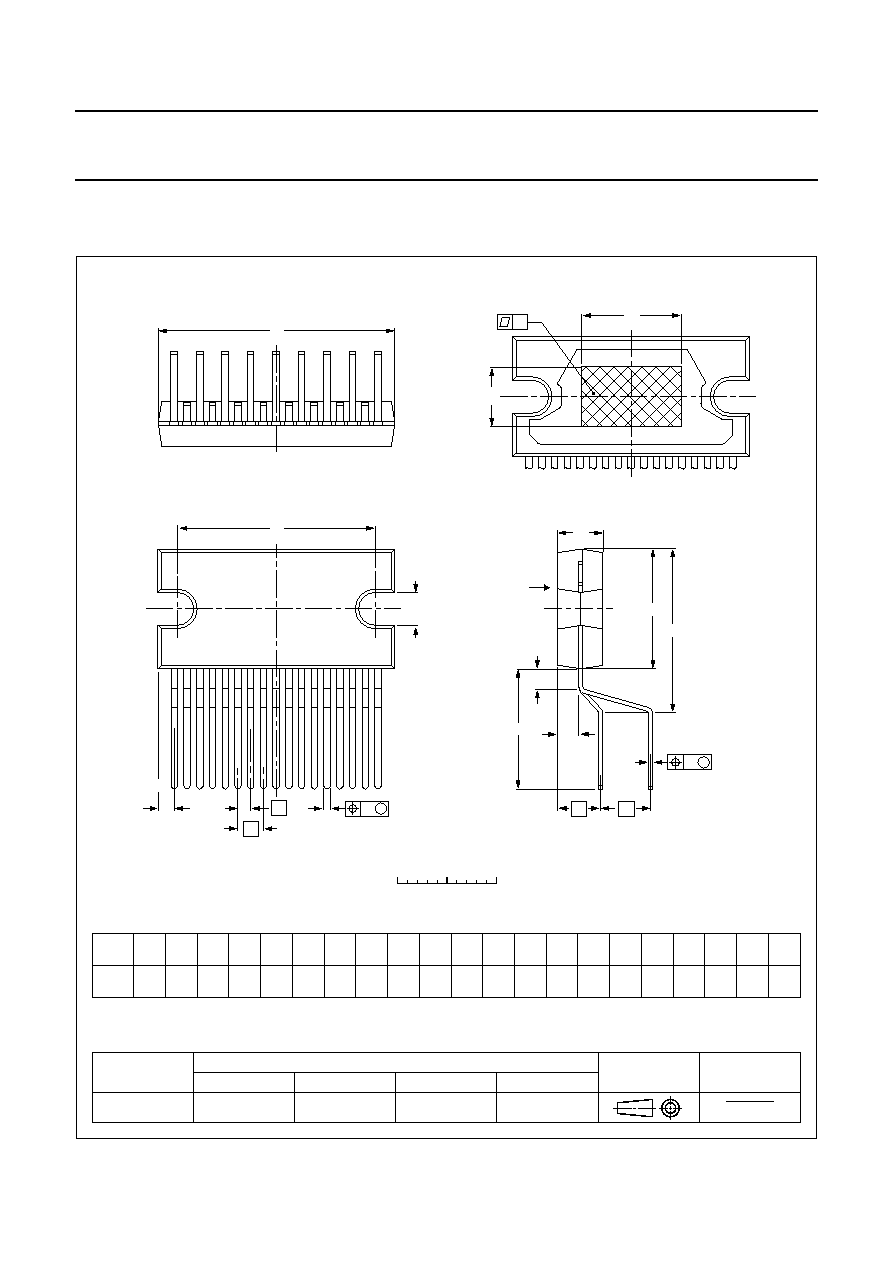 | –≠–ª–µ–∫—Ç—Ä–æ–Ω–Ω—ã–π –∫–æ–º–ø–æ–Ω–µ–Ω—Ç: TDA8566Q | –°–∫–∞—á–∞—Ç—å:  PDF PDF  ZIP ZIP |

DATA SHEET
Product specification
Supersedes data of 1996 Apr 11
File under Integrated Circuits, IC01
1998 Sep 23
INTEGRATED CIRCUITS
TDA8566Q
2
◊
25 W BTL stereo car radio
power amplifier with differential
inputs and diagnostic outputs

1998 Sep 23
2
Philips Semiconductors
Product specification
2
◊
25 W BTL stereo car radio power amplifier
with differential inputs and diagnostic outputs
TDA8566Q
FEATURES
∑
Differential inputs
∑
Very high Common Mode Rejection Ratio (CMRR)
∑
High common mode input signal handling
∑
Requires very few external components
∑
High output power
∑
4
and 2
load driving capability
∑
Low offset voltage at output
∑
Fixed gain
∑
Diagnostic facility (distortion, short-circuit and
temperature pre-warning)
∑
Good ripple rejection
∑
Mode select switch (operating, mute and standby)
∑
Load dump protection
∑
Short-circuit proof to ground, to V
P
and across the load
∑
Low power dissipation in any short-circuit condition
∑
Thermally protected
∑
Reverse polarity safe
∑
Protected against electrostatic discharge
∑
No switch-on/switch-off plop
∑
Flexible leads
∑
Low thermal resistance.
GENERAL DESCRIPTION
The TDA8566Q is an integrated class-B output amplifier
contained in a 17-lead single-in-line (SIL; bent to DIL)
plastic power package. The device contains two amplifiers
in a Bridge-Tied Load configuration (BTL). The output
power is 2
◊
25 W in a 4
load or 2
◊
40 W in a 2
load.
It has a differential input stage and two diagnostic outputs.
The device is primarily developed for car radio
applications.
QUICK REFERENCE DATA
ORDERING INFORMATION
SYMBOL
PARAMETER
CONDITIONS
MIN.
TYP.
MAX.
UNIT
V
P
operating supply voltage
6
14.4
18
V
I
ORM
repetitive peak output current
-
-
7.5
A
I
q(tot)
total quiescent current
-
115
-
mA
I
stb
stand-by current
-
0.1
100
µ
A
I
sw
switch-on current
-
-
40
µ
A
Z
i
input impedance
100
120
-
k
P
out
output power
R
L
= 4
: THD = 10%
-
25
-
W
R
L
= 2
: THD = 10%
-
40
-
W
SVRR
supply voltage ripple rejection
R
s
= 0
-
60
-
dB
cs
channel separation
R
s
= 10 k
-
50
-
dB
CMRR
common mode rejection ratio
-
75
-
dB
G
v
closed loop voltage gain
25
26
27
dB
V
no
noise output voltage
R
s
= 0
-
-
120
µ
V
V
os
DC output offset voltage
-
-
100
mV
TYPE
NUMBER
PACKAGE
NAME
DESCRIPTION
VERSION
TDA8566Q
DBS17P
plastic DIL-bent-SIL power package; 17 leads (lead length 12 mm)
SOT243-1

1998 Sep 23
3
Philips Semiconductors
Product specification
2
◊
25 W BTL stereo car radio power amplifier
with differential inputs and diagnostic outputs
TDA8566Q
BLOCK DIAGRAM
Fig.1 Block diagram.
handbook, full pagewidth
+
-
+
-
CM
VA
(9
◊
)
2.3 k
2.3
k
mute
switch
+
-
+
-
CM
VA
VA
1
◊
standby
reference
voltage
standby
switch
mute
reference
voltage
Vref
mute
switch
CLIP
(9
◊
)
2.3 k
2.3
k
60
k
60
k
60
k
60
k
mute
switch
+
-
+
-
CM
VA
(9
◊
)
2.3 k
2.3
k
mute
switch
+
-
+
-
CM
VA
11
7
12
10
15
4
TDA8566Q
14
8
6
13
5
1
2
3
16
17
VP2
VP1
PGND2
PGND1
OUT2
-
OUT2
+
OUT1
-
OUT1
+
IN1
-
IN1
+
IN2
-
IN2
+
SGND
n.c.
DIAG
MODE
CLIP
MGD105
(9
◊
)
2.3 k
2.3
k
mute
switch
9
DIAG

1998 Sep 23
4
Philips Semiconductors
Product specification
2
◊
25 W BTL stereo car radio power amplifier
with differential inputs and diagnostic outputs
TDA8566Q
PINNING
SYMBOL
PIN
DESCRIPTION
IN1+
1
channel 1 input positive
IN1
-
2
channel 1 input negative
SGND
3
small signal ground
CLIP
4
clip-detection
V
P1
5
supply voltage 1
OUT1+
6
channel 1 speaker output positive
PGND1
7
channel 1 negative power supply
(ground)
OUT1
-
8
channel 1 speaker output negative
n.c.
9
not connected
OUT2+
10
channel 2 speaker output positive
PGND2
11
channel 2 negative power supply
(ground)
OUT2
-
12
channel 2 speaker output negative
V
P2
13
supply voltage 2
MODE
14
mode select switch
(stand-by/mute/operating)
DIAG
15
short-circuit and temperature
pre-warning diagnostic
IN2+
16
channel 2 input positive
IN2
-
17
channel 2 input negative
Fig.2 Pin configuration.
handbook, halfpage
TDA8566Q
MGD101
1
2
3
4
5
6
7
8
9
10
11
12
13
14
15
16
17
IN1
+
IN1
-
SGND
CLIP
VP1
OUT1
+
PGND1
OUT1
-
n.c.
IN2
-
IN2
+
DIAG
MODE
VP2
OUT2
-
PGND2
OUT2
+
FUNCTIONAL DESCRIPTION
The TDA8566Q contains two identical amplifiers and can
be used for BTL applications. The gain of each amplifier is
fixed at 26 dB. Special features of this device are:
1. Mode select switch
2. Clip detection
3. Short-circuit diagnostic
4. Temperature pre-warning
5. Open-collector outputs
6. Differential inputs.
Mode select switch (pin 14)
∑
Standby: low supply current (< 100
µ
A)
∑
Mute: input signal suppressed
∑
Operating: normal on condition.
Since this pin has a very low input current (< 40
µ
A), a low
cost supply switch can be applied. To avoid switch-on
plops, it is advisable to keep the amplifier in the mute mode
for a period of
150 ms (charging the input capacitors at
pins 1, 2, 16 and 17). This can be realized by
microcontroller control or by an external timing circuit
(see Fig.7).
Clip detection (pin 4)
When clipping occurs at one or more output stages, the
dynamic distortion detector becomes active and pin 4
goes low. This information can be used to drive a sound
processor or DC volume control to attenuate the input
signal and so limit the level of distortion. The output level
of pin 4 is independent of the number of channels that are
being clipped. The clip detection circuit is disabled in a
short-circuit condition, so if a fault condition occurs at the
outputs, pin 4 will remain at a high level. The clip detection
waveforms are illustrated in Fig.3.

1998 Sep 23
5
Philips Semiconductors
Product specification
2
◊
25 W BTL stereo car radio power amplifier
with differential inputs and diagnostic outputs
TDA8566Q
Short-circuit diagnostic (pin 15)
When a short-circuit occurs at one or more outputs to
ground or to the supply voltage, the output stages are
switched off until the short-circuit is removed and the
device is switched on again (with a delay of approximately
20 ms after the removal of the short-circuit). During this
short-circuit condition, pin 15 is continuously low.
When a short-circuit occurs across the load of one or both
channels, the output stages are switched off for
approximately 20 ms. After approximately 50
µ
s the load
condition is again checked to see if the short-circuit is still
present. Due to this duty cycle of 50
µ
s/20 ms the average
current consumption during this short-circuit condition is
very low (approximately 40 mA). During this short-circuit
condition, pin 15 is low for 20 ms and high for 50
µ
s (see
Fig.4). The power dissipation in any short-circuit condition
is very low.
Temperature pre-warning (pin 15)
When the junction temperature (T
vj
) reaches 145
∞
C,
pin 15 will become continuously low.
Open-collector outputs
Pins 4 and 15 are open-collector outputs, therefore more
devices can be tied together. Pins 4 and 15 can also be
tied together. An external pull-up resistor is required.
Differential inputs
The input stage is a high-impedance fully differential
balanced input stage that is also capable of operating in a
single-ended mode with one of the inputs capacitively
coupled to an audio ground. It should be noted that if a
source resistance is added (input voltage dividers) the
CMRR degrades to lower values.
Fig.3 Clip detection waveforms.
handbook, halfpage
V4
0
VP
Vout
0
t
MGD103
Fig.4 Short-circuit diagnostic timing diagram.
handbook, full pagewidth
MGA707
short-circuit over the load
20 ms
50
µ
s
t
t
VP
current
in
output
stage
V15

1998 Sep 23
6
Philips Semiconductors
Product specification
2
◊
25 W BTL stereo car radio power amplifier
with differential inputs and diagnostic outputs
TDA8566Q
LIMITING VALUES
In accordance with the Absolute Maximum Rating System (IEC 134).
QUALITY SPECIFICATION
Quality specification in accordance with
UZW-FQ-611-E, if this type is used as an audio amplifier. The number of the
quality specification can be found in the
"Quality Reference Handbook". The handbook can be ordered using the code
9397 750 00192.
THERMAL CHARACTERISTICS
Thermal characteristics in accordance with (IEC 747-1).
SYMBOL
PARAMETER
CONDITIONS
MIN.
MAX.
UNIT
V
P
supply voltage
operating
-
18
V
non-operating
-
30
V
during 50 ms; load dump
protection t
rise
2.5 ms
-
45
V
I
OSM
non-repetitive peak output current
-
10
A
I
ORM
repetitive peak output current
-
7.5
A
T
stg
storage temperature
-
55
+150
∞
C
T
vj
virtual junction temperature
-
+150
∞
C
T
amb
operating ambient temperature
-
40
+85
∞
C
V
psc
short-circuit safe voltage
-
18
V
V
pr
reverse polarity
-
6.0
V
P
tot
total power dissipation
-
60
W
SYMBOL
PARAMETER
VALUE
UNIT
R
th j-c
thermal resistance from junction to case
1.3
K/W
R
th j-a
thermal resistance from junction to ambient in free air
40
K/W
Fig.5 Equivalent thermal resistance network.
handbook, halfpage
2.2 K/W
0.2 K/W
2.2 K/W
virtual junction
output 1
output 2
case
MEA861 - 1

1998 Sep 23
7
Philips Semiconductors
Product specification
2
◊
25 W BTL stereo car radio power amplifier
with differential inputs and diagnostic outputs
TDA8566Q
DC CHARACTERISTICS
V
P
= 14.4 V; T
amb
= 25
∞
C; measured in test circuit of Fig.6; unless otherwise specified.
Notes
1. The circuit is DC adjusted at V
P
= 6 to 18 V and AC operating at V
P
= 8.5 to 18 V.
2. At V
P
= 18 to 30 V the DC output voltage
0.5V
P
.
AC CHARACTERISTICS
V
P
= 14.4 V; T
amb
= 25
∞
C; R
L
= 4
; f
i
= 1 kHz; measured in test circuit of Fig.6; unless otherwise specified.
SYMBOL
PARAMETER
CONDITIONS
MIN.
TYP.
MAX.
UNIT
Supply voltage
V
P
supply voltage
note 1
6
14.4
18
V
I
q
quiescent current
R
L
=
-
115
180
mA
Operating condition
V
ms(op)
mode select switch level
8.5
-
V
P
V
I
14
mode select switch current
V
14
= 14.4 V
-
15
40
µ
A
V
o
output voltage
note 2
-
7.0
-
V
V
os
output offset voltage
-
-
100
mV
Mute condition
V
ms(mute)
mode select switch level
3.3
-
6.4
V
V
o
output voltage
note 2
-
7.0
-
V
V
os
output offset voltage
-
-
100
mV
Standby condition
V
ms(stb)
mode select switch level
0
-
2
V
I
stb
standby current
-
0.1
100
µ
A
Diagnostic
V
15
diagnostic output voltage
during any fault condition
-
-
0.6
V
T
vj
temperature pre-warning
V
15
= 0.6 V
-
145
-
∞
C
SYMBOL
PARAMETER
CONDITIONS
MIN.
TYP.
MAX.
UNIT
P
out
output power
THD = 0.5%
16
19
-
W
THD = 10%
21
25
-
W
THD = 30%
28
35
-
W
THD
total harmonic distortion
P
out
= 1 W
-
0.05
-
%
P
out
output power
V
P
= 13.5 V; THD = 0.5%
-
14
-
W
V
P
= 13.5 V; THD = 10%
-
22
-
W
B
power bandwidth
THD = 0.5%; P
out
=
-
1 dB
with respect to 16 W
-
20 to 20000
-
Hz
f
l
low frequency roll off
-
1 dB, note 1
-
25
-
Hz
f
h
high frequency roll off
-
1dB
20
-
-
kHz
G
v
closed loop voltage gain
25
26
27
dB

1998 Sep 23
8
Philips Semiconductors
Product specification
2
◊
25 W BTL stereo car radio power amplifier
with differential inputs and diagnostic outputs
TDA8566Q
Notes
1. Frequency response externally fixed.
2. V
ripple
= V
ripple(max)
= 2 V (p-p), R
s
= 0
.
3. Dynamic Distortion Detector (DDD) active, pin 4 is low.
4. Common mode rejection ratio measured at the output (over R
L
) with both inputs tied together,
V
common
3.5 V (RMS), f = 100 Hz to 10 kHz, R
s
= 0
.
5. Common mode rejection ratio measured at the output (over R
L
) with both inputs tied together, V
common
3.5 V (RMS),
f = 1 kHz, R
s
= 45 k
. The mismatch of the input coupling capacitors is excluded.
SVRR
supply voltage ripple
rejection
on; note 2
50
-
-
dB
mute; note 2
50
-
-
dB
standby; note 2
80
-
-
dB
Z
i
input impedance
differential
100
120
150
k
single-ended
50
60
75
k
Z
i
input impedance mismatch
-
2
-
%
V
no
noise output voltage
on; B = 20 Hz to 20 kHz;
R
s
= 0
-
85
120
µ
V
on; B = 20 Hz to 20 kHz;
R
s
= 10 k
-
100
-
µ
V
mute; B = 20 Hz to 20 kHz;
independent of R
s
-
60
-
µ
V
cs
channel separation
P
out
= 16 W; R
s
= 10 k
45
-
-
dB
G
v
channel unbalance
-
-
1
dB
V
o
output signal voltage in
mute
V
i
= V
i(max)
= 1 V (RMS)
-
-
2
mV
THD
total harmonic distortion
note 3; V
4
= 0.6 V
-
8
-
%
CMRR
common mode rejection
ratio
R
s
= 0
; note 4
60
75
-
dB
R
s
= 45 k
, note 5
40
-
-
dB
P
out
output power
THD = 0.5%; R
L
= 2
-
30
-
W
THD = 10%; R
L
= 2
-
40
-
W
THD = 30%; R
L
= 2
-
55
-
W
V
P
= 13.5 V; THD = 0.5%;
R
L
= 2
-
25
-
W
V
P
= 13.5 V; THD = 10%;
R
L
= 2
-
35
-
W
THD
total harmonic distortion
P
out
= 1 W; R
L
= 2
-
0.1
-
%
SYMBOL
PARAMETER
CONDITIONS
MIN.
TYP.
MAX.
UNIT

1998 Sep 23
9
Philips Semiconductors
Product specification
2
◊
25 W BTL stereo car radio power amplifier
with differential inputs and diagnostic outputs
TDA8566Q
TEST AND APPLICATION INFORMATION
Fig.6 Stereo BTL test diagram.
handbook, full pagewidth
+
-
+
-
Rs/2
Vmode
Rs/2
Rs/2
Rs/2
Vin2
Vin1
10
k
10
k
RL2
RL1
220 nF
220 nF
60
k
60
k
+
+
-
-
+
-
220 nF
220 nF
60
k
60
k
CLIP
DETECTOR
DIAGNOSTIC
INTERFACE
VP
TDA8566Q
Vref
VP
100
nF
VP =
14.4 V
2200
µ
F/16V
CLIP
DIAG
MGD104
1
+
+
_
+
_
+
_
+
_
_
+
_
6
8
4
15
10
12
7
11
14
13
5
2
3
16
17
Application notes
D
IAGNOSTIC OUTPUT
Special care must be taken in the PCB layout to separate
pin 4 from pins 1, 2, 16 and 17 to minimize the crosstalk
between the CLIP output and the inputs.
M
ODE SELECT SWITCH
To avoid switch on plops, it is advisable to keep the
amplifier in the mute mode during
150 ms (charging of
the input capacitors at pins 1, 2, 16 and 17). The circuit in
Fig.7 slowly ramps-up the voltage at the mode select
switch pin when switching on and results in fast muting
when switching off.
Fig.7 Mode select switch circuit.
handbook, halfpage
100 k
MGD102
47
µ
F
10 k
S
100
mode
select
switch
+
Vsupply

1998 Sep 23
10
Philips Semiconductors
Product specification
2
◊
25 W BTL stereo car radio power amplifier
with differential inputs and diagnostic outputs
TDA8566Q
PACKAGE OUTLINE
REFERENCES
OUTLINE
VERSION
EUROPEAN
PROJECTION
ISSUE DATE
IEC
JEDEC
EIAJ
DIMENSIONS (mm are the original dimensions)
Note
1. Plastic or metal protrusions of 0.25 mm maximum per side are not included.
SOT243-1
0
5
10 mm
scale
D
L
E
A
c
A
2
L
3
Q
w
M
b
p
1
d
D
Z
e
e
x
h
1
17
j
Eh
non-concave
95-03-11
97-12-16
DBS17P: plastic DIL-bent-SIL power package; 17 leads (lead length 12 mm)
SOT243-1
view B: mounting base side
m
2
e
v
M
B
UNIT
A
e
1
A
2
b
p
c
D
(1)
E
(1)
Z
(1)
d
e
D
h
L
L
3
m
mm
17.0
15.5
4.6
4.2
0.75
0.60
0.48
0.38
24.0
23.6
20.0
19.6
10
2.54
v
0.8
12.2
11.8
1.27
e
2
5.08
2.4
1.6
E
h
6
2.00
1.45
2.1
1.8
3.4
3.1
4.3
12.4
11.0
Q
j
0.4
w
0.03
x

1998 Sep 23
11
Philips Semiconductors
Product specification
2
◊
25 W BTL stereo car radio power amplifier
with differential inputs and diagnostic outputs
TDA8566Q
SOLDERING
Introduction
There is no soldering method that is ideal for all IC
packages. Wave soldering is often preferred when
through-hole and surface mounted components are mixed
on one printed-circuit board. However, wave soldering is
not always suitable for surface mounted ICs, or for
printed-circuits with high population densities. In these
situations reflow soldering is often used.
This text gives a very brief insight to a complex technology.
A more in-depth account of soldering ICs can be found in
our
"Data Handbook IC26; Integrated Circuit Packages"
(order code 9398 652 90011).
Soldering by dipping or by wave
The maximum permissible temperature of the solder is
260
∞
C; solder at this temperature must not be in contact
with the joint for more than 5 seconds. The total contact
time of successive solder waves must not exceed
5 seconds.
The device may be mounted up to the seating plane, but
the temperature of the plastic body must not exceed the
specified maximum storage temperature (T
stg max
). If the
printed-circuit board has been pre-heated, forced cooling
may be necessary immediately after soldering to keep the
temperature within the permissible limit.
Repairing soldered joints
Apply a low voltage soldering iron (less than 24 V) to the
lead(s) of the package, below the seating plane or not
more than 2 mm above it. If the temperature of the
soldering iron bit is less than 300
∞
C it may remain in
contact for up to 10 seconds. If the bit temperature is
between 300 and 400
∞
C, contact may be up to 5 seconds.
DEFINITIONS
LIFE SUPPORT APPLICATIONS
These products are not designed for use in life support appliances, devices, or systems where malfunction of these
products can reasonably be expected to result in personal injury. Philips customers using or selling these products for
use in such applications do so at their own risk and agree to fully indemnify Philips for any damages resulting from such
improper use or sale.
Data sheet status
Objective specification
This data sheet contains target or goal specifications for product development.
Preliminary specification
This data sheet contains preliminary data; supplementary data may be published later.
Product specification
This data sheet contains final product specifications.
Limiting values
Limiting values given are in accordance with the Absolute Maximum Rating System (IEC 134). Stress above one or
more of the limiting values may cause permanent damage to the device. These are stress ratings only and operation
of the device at these or at any other conditions above those given in the Characteristics sections of the specification
is not implied. Exposure to limiting values for extended periods may affect device reliability.
Application information
Where application information is given, it is advisory and does not form part of the specification.

Internet: http://www.semiconductors.philips.com
Philips Semiconductors ≠ a worldwide company
© Philips Electronics N.V. 1998
SCA60
All rights are reserved. Reproduction in whole or in part is prohibited without the prior written consent of the copyright owner.
The information presented in this document does not form part of any quotation or contract, is believed to be accurate and reliable and may be changed
without notice. No liability will be accepted by the publisher for any consequence of its use. Publication thereof does not convey nor imply any license
under patent- or other industrial or intellectual property rights.
Middle East: see Italy
Netherlands: Postbus 90050, 5600 PB EINDHOVEN, Bldg. VB,
Tel. +31 40 27 82785, Fax. +31 40 27 88399
New Zealand: 2 Wagener Place, C.P.O. Box 1041, AUCKLAND,
Tel. +64 9 849 4160, Fax. +64 9 849 7811
Norway: Box 1, Manglerud 0612, OSLO,
Tel. +47 22 74 8000, Fax. +47 22 74 8341
Pakistan: see Singapore
Philippines: Philips Semiconductors Philippines Inc.,
106 Valero St. Salcedo Village, P.O. Box 2108 MCC, MAKATI,
Metro MANILA, Tel. +63 2 816 6380, Fax. +63 2 817 3474
Poland: Ul. Lukiska 10, PL 04-123 WARSZAWA,
Tel. +48 22 612 2831, Fax. +48 22 612 2327
Portugal: see Spain
Romania: see Italy
Russia: Philips Russia, Ul. Usatcheva 35A, 119048 MOSCOW,
Tel. +7 095 755 6918, Fax. +7 095 755 6919
Singapore: Lorong 1, Toa Payoh, SINGAPORE 319762,
Tel. +65 350 2538, Fax. +65 251 6500
Slovakia: see Austria
Slovenia: see Italy
South Africa: S.A. PHILIPS Pty Ltd., 195-215 Main Road Martindale,
2092 JOHANNESBURG, P.O. Box 7430 Johannesburg 2000,
Tel. +27 11 470 5911, Fax. +27 11 470 5494
South America: Al. Vicente Pinzon, 173, 6th floor,
04547-130 S√O PAULO, SP, Brazil,
Tel. +55 11 821 2333, Fax. +55 11 821 2382
Spain: Balmes 22, 08007 BARCELONA,
Tel. +34 93 301 6312, Fax. +34 93 301 4107
Sweden: Kottbygatan 7, Akalla, S-16485 STOCKHOLM,
Tel. +46 8 5985 2000, Fax. +46 8 5985 2745
Switzerland: Allmendstrasse 140, CH-8027 ZÐRICH,
Tel. +41 1 488 2741 Fax. +41 1 488 3263
Taiwan: Philips Semiconductors, 6F, No. 96, Chien Kuo N. Rd., Sec. 1,
TAIPEI, Taiwan Tel. +886 2 2134 2865, Fax. +886 2 2134 2874
Thailand: PHILIPS ELECTRONICS (THAILAND) Ltd.,
209/2 Sanpavuth-Bangna Road Prakanong, BANGKOK 10260,
Tel. +66 2 745 4090, Fax. +66 2 398 0793
Turkey: Talatpasa Cad. No. 5, 80640 GÐLTEPE/ISTANBUL,
Tel. +90 212 279 2770, Fax. +90 212 282 6707
Ukraine: PHILIPS UKRAINE, 4 Patrice Lumumba str., Building B, Floor 7,
252042 KIEV, Tel. +380 44 264 2776, Fax. +380 44 268 0461
United Kingdom: Philips Semiconductors Ltd., 276 Bath Road, Hayes,
MIDDLESEX UB3 5BX, Tel. +44 181 730 5000, Fax. +44 181 754 8421
United States: 811 East Arques Avenue, SUNNYVALE, CA 94088-3409,
Tel. +1 800 234 7381
Uruguay: see South America
Vietnam: see Singapore
Yugoslavia: PHILIPS, Trg N. Pasica 5/v, 11000 BEOGRAD,
Tel. +381 11 625 344, Fax.+381 11 635 777
For all other countries apply to: Philips Semiconductors,
International Marketing & Sales Communications, Building BE-p, P.O. Box 218,
5600 MD EINDHOVEN, The Netherlands, Fax. +31 40 27 24825
Argentina: see South America
Australia: 34 Waterloo Road, NORTH RYDE, NSW 2113,
Tel. +61 2 9805 4455, Fax. +61 2 9805 4466
Austria: Computerstr. 6, A-1101 WIEN, P.O. Box 213, Tel. +43 160 1010,
Fax. +43 160 101 1210
Belarus: Hotel Minsk Business Center, Bld. 3, r. 1211, Volodarski Str. 6,
220050 MINSK, Tel. +375 172 200 733, Fax. +375 172 200 773
Belgium: see The Netherlands
Brazil: see South America
Bulgaria: Philips Bulgaria Ltd., Energoproject, 15th floor,
51 James Bourchier Blvd., 1407 SOFIA,
Tel. +359 2 689 211, Fax. +359 2 689 102
Canada: PHILIPS SEMICONDUCTORS/COMPONENTS,
Tel. +1 800 234 7381
China/Hong Kong: 501 Hong Kong Industrial Technology Centre,
72 Tat Chee Avenue, Kowloon Tong, HONG KONG,
Tel. +852 2319 7888, Fax. +852 2319 7700
Colombia: see South America
Czech Republic: see Austria
Denmark: Prags Boulevard 80, PB 1919, DK-2300 COPENHAGEN S,
Tel. +45 32 88 2636, Fax. +45 31 57 0044
Finland: Sinikalliontie 3, FIN-02630 ESPOO,
Tel. +358 9 615800, Fax. +358 9 61580920
France: 51 Rue Carnot, BP317, 92156 SURESNES Cedex,
Tel. +33 1 40 99 6161, Fax. +33 1 40 99 6427
Germany: Hammerbrookstraþe 69, D-20097 HAMBURG,
Tel. +49 40 23 53 60, Fax. +49 40 23 536 300
Greece: No. 15, 25th March Street, GR 17778 TAVROS/ATHENS,
Tel. +30 1 4894 339/239, Fax. +30 1 4814 240
Hungary: see Austria
India: Philips INDIA Ltd, Band Box Building, 2nd floor,
254-D, Dr. Annie Besant Road, Worli, MUMBAI 400 025,
Tel. +91 22 493 8541, Fax. +91 22 493 0966
Indonesia: PT Philips Development Corporation, Semiconductors Division,
Gedung Philips, Jl. Buncit Raya Kav.99-100, JAKARTA 12510,
Tel. +62 21 794 0040 ext. 2501, Fax. +62 21 794 0080
Ireland: Newstead, Clonskeagh, DUBLIN 14,
Tel. +353 1 7640 000, Fax. +353 1 7640 200
Israel: RAPAC Electronics, 7 Kehilat Saloniki St, PO Box 18053,
TEL AVIV 61180, Tel. +972 3 645 0444, Fax. +972 3 649 1007
Italy: PHILIPS SEMICONDUCTORS, Piazza IV Novembre 3,
20124 MILANO, Tel. +39 2 6752 2531, Fax. +39 2 6752 2557
Japan: Philips Bldg 13-37, Kohnan 2-chome, Minato-ku,
TOKYO 108-8507, Tel. +81 3 3740 5130, Fax. +81 3 3740 5077
Korea: Philips House, 260-199 Itaewon-dong, Yongsan-ku, SEOUL,
Tel. +82 2 709 1412, Fax. +82 2 709 1415
Malaysia: No. 76 Jalan Universiti, 46200 PETALING JAYA, SELANGOR,
Tel. +60 3 750 5214, Fax. +60 3 757 4880
Mexico: 5900 Gateway East, Suite 200, EL PASO, TEXAS 79905,
Tel. +9-5 800 234 7381
Printed in The Netherlands
545102/750/03/pp12
Date of release: 1998 Sep 23
Document order number:
9397 750 04335











